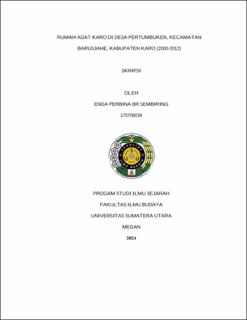| dc.contributor.advisor | Hati, Lila Pelita | |
| dc.contributor.advisor | Ginting, Lestari Dara Cinta Utami | |
| dc.contributor.author | Sembiring, Enda Perbina Br | |
| dc.date.accessioned | 2025-05-06T04:26:04Z | |
| dc.date.available | 2025-05-06T04:26:04Z | |
| dc.date.issued | 2024 | |
| dc.identifier.uri | https://repositori.usu.ac.id/handle/123456789/103650 | |
| dc.description.abstract | This research focuses on the "Karo Traditional House in Pertumbuken Village, Barusjahe District, Karo Regency (2000-2012)". This study aims to explain the existence of the Karo traditional house in Pertumbuken Village, which has been largely abandoned by its inhabitants. This research method uses the historical research method. Next is the heuristic stage (source collection), where the author uses primary sources such as archives, photos, and interviews. The secondary sources needed include books, journals, or other scholarly works. The sources are then verified (criticized), through external criticism to obtain the authenticity of the sources and internal criticism to produce historical facts. Then, the results of the verification are interpreted in the form of analysis and synthesis to produce a historical narrative. Finally, historiography reconstructs the historical facts that have been collected. The research results show that the Karo Traditional Houses from 2000-2012 in Pertumbuken Village, Barusjahe District, Karo Regency can be said to be in crisis because from 2000-2012 these traditional houses were unoccupied. Many people choose to move and build their own houses rather than live in traditional Karo houses that are occupied by more than one family. The phenomenon of many empty or even damaged traditional houses also impacts social changes in the Pertumbuken village community, in the sense that the spirit of mutual cooperation is slowly fading and moving towards a more individualistic direction. Similarly, in terms of the number of traditional houses and the population, there has been a decline due to people migrating (moving) to areas they consider more suitable for habitation compared to those traditional | en_US |
| dc.language.iso | id | en_US |
| dc.publisher | Universitas Sumatera Utara | en_US |
| dc.subject | Pertumbuken Village 2000-2012 | en_US |
| dc.subject | Karo | en_US |
| dc.subject | Karo Traditional House | en_US |
| dc.title | Rumah Adat Karo di Desa Pertumbuken, Kecamatan Barusjahe, Kabupaten Karo (2000-2012) | en_US |
| dc.title.alternative | Karo Traditional House in Pertumbuken Village, Barusjahe District, Karo Regency (2000-2012) | en_US |
| dc.type | Thesis | en_US |
| dc.identifier.nim | NIM170706034 | |
| dc.identifier.nidn | NIDN0023056703 | |
| dc.identifier.nidn | NIDN0003049006 | |
| dc.identifier.kodeprodi | KODEPRODI80201#Ilmu Sejarah | |
| dc.description.pages | 93 Pages | en_US |
| dc.description.type | Skripsi Sarjana | en_US |
| dc.subject.sdgs | SDGs 9. Industry Innovation And Infrastructure | en_US |


